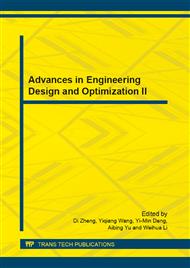p.392
p.396
p.400
p.405
p.410
p.414
p.418
p.422
p.427
Optimal Design of Configuration Change Program for Tactical Missile with Morphing Wings
Abstract:
The flight Performance of missile can be improved by adaptive morphing wing serving as main lift surface. A novel compounded morphing missile, a complicated nonlinear and non-analytical multivariable constrained optimization problem, is modeled to design adaptive program of the wing geometry versus flight states. Based on reformed optimal algorithms such as Monte Carlo and Particle Swarm Optimization (PSO), a set of integrated approach is developed to optimize the shape change program of wings by interactively reading and writing data files from missile DATCOM. The simulation results show that the proposed algorithms can be used to obtain an optimal missile configuration over large flight envelope, characterized by maximal lift-to-drag ratio and a required normal overload.
Info:
Periodical:
Pages:
410-413
Citation:
Online since:
September 2011
Authors:
Price:
Сopyright:
© 2012 Trans Tech Publications Ltd. All Rights Reserved
Share:
Citation:


